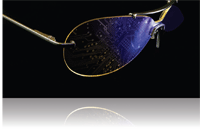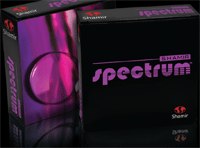A progressive addition lens (PAL) is a type of multifocal that offers a smooth, seamless transition between zones of increased add power. Unlike simple bifocals and trifocals, PALs provide the desired add power without breaks, ledges, lines or abrupt jumps between distance and near viewing zones.
When it comes to ophthalmic lens selection, many optometrists and opticians believe that PALs hold numerous advantages over more conventional lens designs. “Progressive addition lenses improve the lives of countless patients who have developed presbyopia,” says Timothy Coronis, A.B.O.C.-N.C.L.E., of Keene, N.H. “With their ability to correct vision at a variety of distances and with presbyopia a natural inevitability for most, PALs are an attractive vision correction option for a growing segment of the aging population.”
Currently, there are more PAL designs on the market than ever before. The newest designs are fully customizable with digital surfacing, freeform technology and wavefront design. “The biggest advancement in PALs in recent years has been the development of digitally surfaced lenses,” says Mr. Coronis. “Software creates a virtual PAL for a particular prescription, corrects areas of imperfect optics that are specific to that patient’s prescription and customizes the design of the digital PAL to that prescription and shape.” Additionally, the most advanced PALs are comprised of thinner, lighter and more durable materials, making these lenses more comfortable than ever before (see, “PAL Material Selections,” below).
Because such cutting-edge advancements continue to hit the market at an unprecedented rate, keeping up with the latest PAL designs can be challenging. Here, we review several of the latest and most advanced PAL designs.
Definity Fairway Transitions SOLFX

- Essilor
Definity Fairway Transitions SOLFX lenses, from Essilor, are designed to meet the unique visual demands of presbyopic golfers. The Definity Fairway combines the Dual Add technology and Ground View Advantage of Definity lenses with the advanced photochromic technology of Transitions SOLFX lenses to enhance golfers’ vision on the course in all outdoor sun conditions. Additionally, the Definity Fairway comes standard with Crizal Sun Mirrors with Scotchguard Protector to resist surface scratching and smudging.
“The Dual Add Technology maximizes the available design space of the lens and provides the least amount of peripheral distortion while providing a smoother transition between all distances,” says Peter Shaw-McMinn, O.D., assistant professor of clinical studies at the Southern California College of Optometry and senior partner of Sun City Vision Center in California. “Through Dual Add Technology and digital surfacing, the add power is uniquely split over both the front and back of the lens to optimize optics and minimize distortion.”
According to the company, the Definity Fairway will allow the wearer to:
• Read greens more effectively in any sun condition.
• See the ball more clearly through all zones of vision.
• Optimize his/her overall performance on the course.
iZon High Resolution Progressives

- Ophthonix
iZon High Resolution Progressive lenses, from Ophthonix, are individually customized using wavefront technology to measure and map the “optical fingerprint” of the wearer’s eye. “The process starts with an analysis of 11,300 points on each of a patient’s eyes with the company’s Z-View Aberrometer,” says Arnie Patrick, O.D., assistant professor at Nova
Southeastern University College of Optometry in Ft. Lauderdale, Fla. “Then, it creates a wavefront distortion map, or ‘iPrint.’ The data is then transmitted to Ophthonix, where the lenses are made.”
The specialized wavefront correction process specifically addresses all second- through sixth-order aberrations, including halos, starbursts and comets around lights at night; compromised depth perception; low contrast sensitivity; and perceptual sensitivity to color. And, according to the company, the customized design process accounts for all variations of the eye and allows presbyopic patients to experience crisp, “high-definition” vision across a variety of near, intermediate and far viewing distances.
Hoyalux iQ Summit
- Hoya

The Hoyalux iQ Summit, by Hoya, is created with TrueForm Technology, which yields a progressive distribution on the lens front as well as point-by-point free form back surfacing to deliver an individually customized design.
TrueForm technology allows the lens surface to be cut “pixel perfect” along a series of multiple axes, compared to just two axes in many conventional PAL designs. This allows the lenses to be cut and polished with high precision, resulting in a uniquely calculated and individualized design.
According to the company, Hoyalux iQ Summit delivers:
• Enhanced visual performance along each line of sight.
• Less visual distortion.
• Wider fields of vision.
• Improved distance vision.
New Varilux Comfort
- Essilor
New Varilux Comfort lenses have been designed using Essilor’s proprietary Live Optics research and development process to facilitate smoother, more natural transitions between near, intermediate and far viewing distances. According to the company, the New Varilux Comfort design offers the following upgrades to the previous Varilux Comfort lens:
• The progression length has been shortened.

• The near vision and distance vision fields are up to 25% wider.
• The intermediate zone features reduced astigmatism.
These upgrades provide the wearer with easier access to the near vision zone, deliver wider fields for relaxed vision during daily activities and help to reduce swim for more rapid adaptation.
“Today’s visual environment is more dynamic than in the past and requires constant changes in viewing distance,” says Dr. Patrick “This time-honored lens has been updated to account for the way in which the increased usage of digital devices has changed our visual behavior.”
Spectrum
- Shamir

Shamir Spectrum lenses are designed with the company’s proprietary EyePoint Technology and Direct Lens Technology & Prescriptor Software to provide enhanced distance vision stability and a 20% wider progressive corridor than its Element lens.
According to the company, EyePoint Technology features a 3D ray-tracing program that simulates the human eye at every angle of the optical zone and helps to predict how the brain will perceive an image. Then, EyePoint Technology uses these predictions to develop a lens design with aspheric/atoric compensations that deliver the required power at all necessary anatomical locations.
Additionally, the Direct Lens Technology & Prescriptor Software captures each patient’s personalized information and generates a personalized lens. This information is then sent to the freeform production equipment, which grinds the specified design on the back surface of the lens.
Surmount

- Seiko
Surmount, from Seiko, is designed with newly patented technology that allows the lenses to be significantly thinner than other conventional PALs. “Convex Add-Power Curve Technology, an advancement in the company’s internal freeform design, allows the processing of convex curves on the concave surface of the lens,” Dr. Patrick says. “When combined with new prism thinning calculations, the company suggests that plus prescriptions can be as much as 25% thinner than similar freeform designs.”
PAL Material Selections
By Timothy Coronis, A.B.O.C.-N.C.L.E.
Each material has unique qualities. It is important to choose lens materials based on what’s best for the job, not “cafeteria-style” from a slew of choices. Evaluate available options, then make your recommendations. Be prepared with your reason why one choice is the best in a particular case. Present this option first, and make sure the patient understands why this is your preferred option.
• Polycarbonate has unsurpassed impact resistance, an Abbe value of 30 (the higher the Abbe value, the lower the chromatic aberration) and an index of 1.59. Most progressive designs are available in polycarbonate, making it the material of choice for sport or safety applications. At 1.59, it is lighter and thinner than standard plastic, which has a 1.5 index.
Initially, polycarbonate was considered a high-index option. As higher-index material became available, polycarbonate’s best feature became its impact resistance. The mass production of the polycarbonate CD led to purer polycarbonate and compatibility with hard surface treatments.
• Materials with a higher index of 1.67 is thinner than polycarbonate. It has a greater tensile strength and better resistance to chipping at drill holes than polycarbonate, making 1.67 an ideal choice for most drilled rimless frames. Its Abbe value is 34. Lenses with an index of 1.67 are thinner than polycarbonate (1.59), but also have lower impact resistance.
For high-power prescriptions, lens materials are available in indices as high as 1.71 or 1.74.
• The impact resistance of Trivex (PPG Industries) is similar to that of polycarbonate, and it has an excellent Abbe value of 43. Its refractive index puts it in the mid-index range, at 1.53.
• Standard plastic is still widely available in most PAL designs. Standard plastic (CR-39, PPG Industries) is the most inexpensive lens material. However, it is not as impact-resistant as polycarbonate, and at an index of 1.49, not as thin and light as other materials. Its Abbe value is 58. Standard plastic boasts low cost, ubiquitous availability and the greatest range of tintability of all materials.
Additionally, Surmount uses Advanced Aspheric Compensation to improve vision throughout the entire lens by compensating for various factors, such as eye rotation, even in prescriptions with high cylinder.
“As an as-worn design, such factors as vertex distance and pantoscopic tilt are also accounted for, so the final lens power will be different than what the clinician prescribed,” adds Dr. Patrick.

